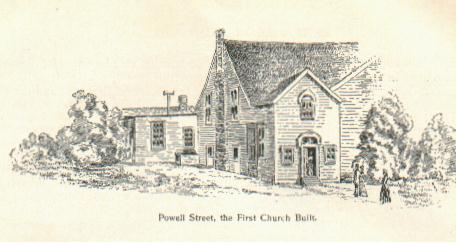
Powell
Street, the First Church Built
METHODISM IN CALIFORNIA
By Rev. A. C. Hirst, D. D., LL. D.
No. I
December, 1892.
Tracing some of the lines of its past history; analyzing some of its present conditions and possibilities, and finding there a rosy and inspiring prophecy of the future mission and success of Methodism on the Pacific Coast, and especially in an around San Francisco--is the explanation for this, and a succeeding article, finding a place in the pages of THE CALIFORNIAN.
This will bring briefly under review the genius of Methodism and its present status in San Francisco, some of the causes for its normal development, it's mission and opportunity, its educational interests and its prospects for future success.
The student of history has failed to accumulate aggressive force for his intellectual life, if he masters the historic page only as a correct record of facts in individual or national life, and fails to discern in the grand march of history the Devine plan and purpose.† He fails even to hold the facts in the grasp of a clearer apprehension, unless in the strong light of some great principle or positive law of which these facts are the illustration.
There is a ringing emphasis in the strong words of the recent writer: "The history of religion is the history of man.† The chronicles of nations, made up as they are of wars of revolutions, political formations and decays, dynasties and parties, institutions affecting the temporal and material well-being of their subjects--these, and the like of these, are properly no part (or a very subordinate part) of the history of man.† These are accidents, not substance; episodes, not methods.† The true history, the thread on which these are strong, is the progressive life of the spirit which binds the nations in one providential order, and which alone gives meaning to man's being in time."† This exalting principle maintains its supremacy the in the State as well as in the national and international history.† Hence the careful study of the progress of Christianity in the city and State is of intense interest and value.
Another fact challenges attention: that the splendid achievements which have refined, purified an exalted civilization, and prove the world to lift herself and shake her awful front into the light, were made possible real by the heroism of noble spirits, who, through self-abnegation, loyalty to truth and fidelity to high purpose, ceased their crowns.
The rich beauty poured from the invisible urns in the golden splendor of the sunset hour have no such power to move the soul of lofty aspiration and two deeds of heroism as the richer atmosphere of human love and truth and faith that rolls down upon the world from such great souls.† It is the incarnation of truth in human hearts that marks the real progress of the world.† It's fruitage is science, art, philanthropy, patriotism, conquering enthusiasm, unselfish devotion, self-sacrificing zeal, the emancipation of women, the broken chains of the slave, the subdued passions of men, the development of his stalwart character, the building of grand manhood.

It sings to its triumphs in the answer of the devoted missionary to the efforts of friends to break the power of a noble conception over his soul:
Hush you!† Close your dismal story,
What to me are
tempests wild?
Heroes on the way
to glory
Heed not pastimes
of the child.
For the souls of
man I'm sailing;
Blow, he winds,
north, south, east, west,
Though the storm be
rounded the wailing
There'll be peace
within my breast.
When the sublime, fundamental principles of the Republic of Righteousness that the Divine Teacher founded in the world to become incarnated in the human heart, unfragrant selfishness blossoms into fragrant self-hood, and utters its splendid protest against any limit of the power of life filled with the infinities of goodness, benevolence, truth and heaven.† The Divine Ideal, shining with holy light and inspiring with the foregleams of eternity, flashes forth its power.† The unspeakable value of manhood is revealed, and man is in alliance with fraternity with all the pittance.† This uncovers the genesis of greatness.† This is genuine enthusiasm.† This is truest heroism.† It is human capacity filled with divine fullness.† It is human possibility aglow and the unfolded into conquering power by divine energy.
Methodism, in its organic life, grandly aroused and developed the spirit of self-sacrifice and holy daring.† Her pioneer preachers were true heroes.† Their preaching was soul-stirring, new, wonderful, entrancing.† Multitudes thronged to hear them in the "old log schoolhouse," the barn, the grove, the private dwelling.† Their names may not be emblazoned on the world's calendar, but the institutions of the land bear the impress of their work, and have been strengthened and enriched thereby.† The iron teeth of Time can never destroy their record.† Their age stands forth as one of the grandest epochs that characterize the history of the world's redemption, because stamped with their sublime heroism.† The heritage of such lives is priceless.† Such, for illustration, in the early historic days of Methodism in this nation was that of Francis Asbury, peerless and irresistible in his great life-purpose.
"The swamps and the rivers, the wilderness and the mountains, savage Indians and wild beasts of the forest, the longest reaches of distance and the most laborious modes of travel were as nothing in his presence, while he moved on ceaseless, tireless, in circuits that stay on the half the continent."
During the forty-five years of his ministry he traveled 270,000 miles, mostly in sulky and on horseback.† He preached 16,500 sermons, and as bishop presided at 225 annual conferences and ordained 4,000 preachers.† During those eventful years, he saw the church grow in membership from 600 to 211,000, and from 10 preachers to 3,000.
Methodism today moves forward as the sublime fact of a spiritual force and splendid organization, interpenetrating the souls of men and pressing them onward to God in developing a refined an exalted manhood.
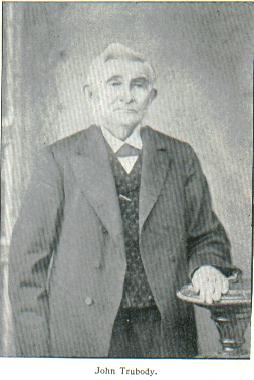
The Rev. Dr. Bellows, in 1866, gave his testimony to this genius of Methodism.† "Methodism," said he, "commenced as an inspiration.† It grew out of necessity.† It met a want.† It performed a mighty and holy work.† Its missionaries have gone down among the poor with their precious messages of penitence and loved and faith.† They have followed the emigrant into the wilderness, and been the pioneers of civilization, scattering the seeds of virtue and enlightenment in waste and desert places.† They have done more than can be estimated to restrain, elevate and educate the common people of our land.† There are no moral census tables to tell in mathematical figures the real good Methodism has done in improving the manners and morals of the people and influencing the higher life of society."
California was a most inviting field for such a moral and spiritual force as this, and for the self-sacrificing and persistent work of men and women under its control.† Such preachers and layman came, and by their wisdom, wonderful adaptability to the particular conditions, unyielding loyalty of purpose and glowing enthusiasm, rested victory from seeming defeat.† They transformed opposition into harmonious co-operation, softened the harsh disparities of a wild unbelief, and sent streaming into the lawless and riotous living a restraining and self-mastering power that was largely to determine the quality and quantity of the moral currents, for the future of the city and State.
They were men of intense conviction, to whom the gospel was not a theory but a Divine reality, a rich personal experience.† To them the sublime facts of the judgment, heaven, hell, life and death were vivid realities.† Those early days inspired the forces that were to determine the future civilization of the State.† Materialism, sensualism, feverish restlessness swayed the thoughts of men and directed their lives.† The spirit of Christianity was needed.† The horizon lifted at its coming.† The prophecy of the coming years was read by the men of faith, who have left as a heritage lessons of patience, of self-denial, of self-conquest, of mastery over a forest of difficulties, and through whose lips there came the thoughts of God.
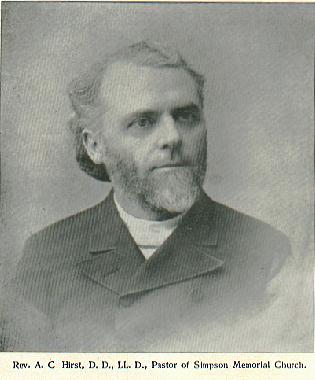 Action explains and verifies
thought.† Action glorifies thought.† Goodness is militant, and, like a sword, is
made for war, flashing and striking as the antagonist of all wrong.† A strong, symmetrical manhood incarnates
goodness and truth, enshrines boundless powers and appeals to eternity before
the fadeless laurels of victory it wins on the battle lines of Time.
Action explains and verifies
thought.† Action glorifies thought.† Goodness is militant, and, like a sword, is
made for war, flashing and striking as the antagonist of all wrong.† A strong, symmetrical manhood incarnates
goodness and truth, enshrines boundless powers and appeals to eternity before
the fadeless laurels of victory it wins on the battle lines of Time.
Most interesting and romantic is the history of Methodism in the country and all among the miners, in the days when the gold mania held its way.† If a careful record of the church life during that period could be secured it would show how true, brave and heroic the pioneer itinerant was, and what hardships and toils he endured in planting the gospel in California.† Facts more wonderful and startling then fiction centralize about Shasta, Coloma, Grass Valley and Nevada City.† The names of Revs. John B. Hill, Adam Bland, C. V. Anthony, W. S. Urmy, H. B. Sheldon, and others, will pass into history as men of dauntless courage, conquering faith and tireless zeal.† The three last-named are still honored and active members of the California Conference.† Wonderful things are told of John B. Hill's glowing enthusiasm and self-sacrifice.† In the year 1852, he built a church in Shasta overlooking the town.† The building was plain and unattractive, of rough boards set on end and battened.† There were three windows on each side and door in the end.† Shasta had a population of 1,500 inhabitants and was the headquarters for the mule trains.† The people were eager for gold.† This was intensely demoralizing.† Irreligion and profligacy repelled the restraints, reproofs and warnings of the gospel.† This stubborn indifference and opposition were only an inspiration to the undaunted Hill.† He worked earnestly with his own hands in the erection of the little church.† He boarded himself in an old shanty nearby, joyous in his toil.† He walked to Weaverville and preached, and from Downieville to Forest City, and delivered his burning message.† He was his own chorister and janitor.† Storm or snowdrift, reckless living or blatant infidelity brought no defeat to hit this courageous, itinerant Methodist preacher.
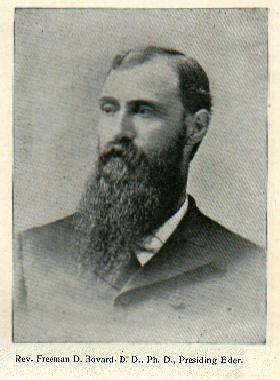 H. B. Sheldon came to the State
in 1852.† He was one of the mountain
preachers active, earnest, brave, and capable of great physical endurance.† He was gifted with a good voice and could
sing with fine effect which gave him popularity among the miners.† He was often admitted to preach and saloons and
gambling dens.† With unflinching
infidelity he declared the truth.† One incident
will give an insight into this phase of his work.† At one time, at "Indian Diggings,"
ten miles from Volcano, he preached in a large tent were twenty tables of
gamblers were planted, each table full.†
In that vile atmosphere of the city, profanity and mad speculation, the
preacher was admitted by the proprietor who said to the gamblers and visitors,
"Boys, would you like to hear some good singing and preaching?"† "Yes," was the reply of these
reckless men.† The games were temporarily
closed, cloths were thrown over the gold coin, cigars were lighted, and the
gamblers thus prepared for the service, which was introduced by music from the
brass band which was a part of the gambling institution.
H. B. Sheldon came to the State
in 1852.† He was one of the mountain
preachers active, earnest, brave, and capable of great physical endurance.† He was gifted with a good voice and could
sing with fine effect which gave him popularity among the miners.† He was often admitted to preach and saloons and
gambling dens.† With unflinching
infidelity he declared the truth.† One incident
will give an insight into this phase of his work.† At one time, at "Indian Diggings,"
ten miles from Volcano, he preached in a large tent were twenty tables of
gamblers were planted, each table full.†
In that vile atmosphere of the city, profanity and mad speculation, the
preacher was admitted by the proprietor who said to the gamblers and visitors,
"Boys, would you like to hear some good singing and preaching?"† "Yes," was the reply of these
reckless men.† The games were temporarily
closed, cloths were thrown over the gold coin, cigars were lighted, and the
gamblers thus prepared for the service, which was introduced by music from the
brass band which was a part of the gambling institution.
Sheldon sang a touching hymn, offered prayer and preached. †When this strange service closed, someone said: "Boys, this man can't live on Hallelujah, I am going home; get out the dust."† And a generous collection was taken, with an old slouch hat as collection-box.† Who can tell what sacred memories that hymn, prayer and sermon aroused in the hearts of those men who had left home, church and a refining civilization, in search of gold?
Who can paragraph the resolves quietly made in that impressive hour for a noble manhood?† In the great whirl of the intense, unrestrained, adventurous, wicked life, men were made to feel that spiritualities were here in all their power; that the moral law made the same imperative demands upon them here as it in more civilized centers from whence they came; that moral responsibility was the same as in the old home--as on the old farm across the Rockies.
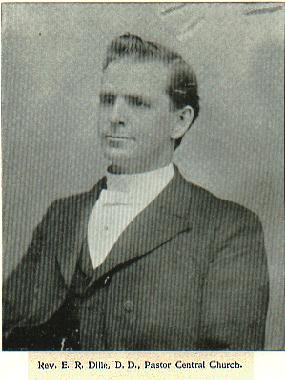 Some of the noble man who stood
firm in those surging tides of immorality, striking masterful blows for purity
and progress, still live in San Francisco and vicinity.† Whom can the State more worthily honor than
these veteran heroes?† To them, more than
to any others, is due the place California holds among the sisterhood of
States--the fairest, the richest of them all in climate, fruitage, resources
and possible development.†
Some of the noble man who stood
firm in those surging tides of immorality, striking masterful blows for purity
and progress, still live in San Francisco and vicinity.† Whom can the State more worthily honor than
these veteran heroes?† To them, more than
to any others, is due the place California holds among the sisterhood of
States--the fairest, the richest of them all in climate, fruitage, resources
and possible development.†
These men, who organized the church in California, were men of great faith and brave purpose.† They built on solid foundations, and, as if with prophetic vision, they sought to plan for the future material prosperity of the State, as well as for the progress of Christianity, by their fidelity amid the leaping torrents of worldliness and the mad frenzy for gold.
The peculiar conditions that confronted them aroused their best energies, and gave an irresistible force to the message of truth they brought to the minds of men.
Among those now living may be mentioned Rev. M. C. Briggs, D. D., who arrived in San Francisco, October 16, 1850, and soon after began his work as pastor in Sacramento, and who is still in the successful work of pastorate in Petaluma.† If the pen of some historian would paragraph the unwritten history crystallized about Dr. Briggs during these years as pastor, editor and leader of the best political thought of California, in her crucial hours as a new State, and especially in the crimson days of the rebellion, an insight into the heroism of those early days would be given that would awaken gratitude for the directive potency of Christian character and its rich fruitage, and arouse grander purposes among the churches for he enthusiastic, aggressive work, as the new century dawn with inspiring promise.† His commanding personality has been a leading factor in shaping the Methodism of California.
Another of these pioneer preachers is Rev. S. D. Simonds, who came with Dr. Briggs, and, after years of devoted and faithful service, is living a quiet life in San Francisco, hopefully awaiting the summons to reward.† His record as editor of the California Christian Advocate, in these historic days, will remain as a monument to his memory.† The columns of his paper were aflame with his burning protest against the immoralities of the day.† So vigorous were his blows against gambling, vice, hypocrisy and libertinism, that two determine efforts were made to assassinate him.† His life was in sacred keeping, and the assassin failed in his fiendish purpose.† A few others of those preachers still live to rejoice in the wonderful growth of Methodism since its first planting, of whom mention will be made hereafter.
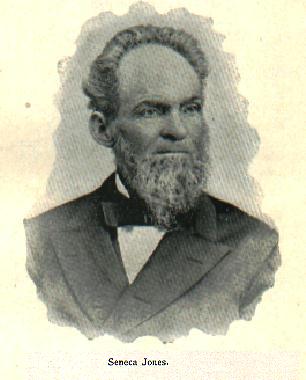 The announcement of the transfer
of these stalwart preachers was received by Rev. William Taylor in May, 1850,
from Rev. J. P. Durbin, D. D., Missionary Secretary of the Methodist Episcopal
church.† Also of the transfer of Rev.
Edward Barrister, who was to be placed in charge of the educational work.† Such a reinforcement was prophetic of large
results in church work.
The announcement of the transfer
of these stalwart preachers was received by Rev. William Taylor in May, 1850,
from Rev. J. P. Durbin, D. D., Missionary Secretary of the Methodist Episcopal
church.† Also of the transfer of Rev.
Edward Barrister, who was to be placed in charge of the educational work.† Such a reinforcement was prophetic of large
results in church work.
Rev. S. D. Simonds was very sick with typhus fever on his arrival in San Francisco, but on his recovery preached as opportunity offered, north of the bay.† On the 27th of April, 1851, he organized and superintended the first Methodist camp meeting on the Pacific Coast.† It was held at Sonoma and was the successful campaign for souls.† The enthusiasm, spiritual fervor and wise adaptability to rude conditions of the superintendent transformed the primitive simplicity and perplexing inconveniences environing the camp meeting into forces for spiritual victory.† In August, 1851, he was appointed the pastor of Powell Street church, succeeding Rev. William Taylor, the first pastor of the same church.† In October, 1851, with Dr. Briggs as associate editor, he issued the first number of the California Christian Advocate, which is still in circulation as a most helpful and educating agency, and is under the wise editorial management of Rev. B. F. Crary, D. D.
Great opportunities were here, scarcely realized by the most thoughtful and sanguine of these pioneers of Methodism.† Had prophetic vision been granted them, how grandly they might have planned and built for these years, and what a tremendous week the mental, moral and spiritual forces they would have started.
Bishop Simpson, during a
visit to San Francisco in February, 1854, wrote to a friend in the East:
"There is a wide field for usefulness here, and there are a few who seem
to comprehend the actual condition of things.†
I have been very warmly urged to fix my residents here, and I think I
could spend a few years very pleasantly in trying to lay the foundations of the
church on the Pacific Coast.† It is
strange and familiar country.† Everything
in society is on a grand scale.†
Everything is under high pressure, and I believe great good might be
done by plans well directed and promptly and vigorously executed."
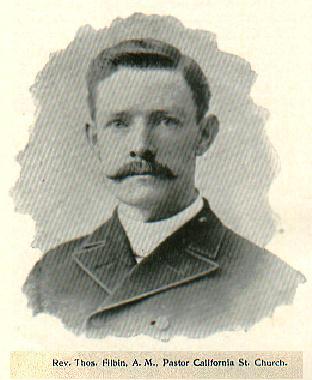 That
bit of gold found in the raceway of Sutter's mill on the Americans Fork of the
Sacramento River, was a magic and masterful key to the treasure-house of the
immense mineral wealth of this great State.†
The intense thrill of this discovery leaped through the land.† Hitherward the adventurers and gold hunters
came.† Representatives from all the world
turned to the "Golden State."†
California, from being nearly unknown and unsettled, sprang into a
mighty state with the force that shook the nation.† Onward has been the march of her
civilization, in giant strides.
That
bit of gold found in the raceway of Sutter's mill on the Americans Fork of the
Sacramento River, was a magic and masterful key to the treasure-house of the
immense mineral wealth of this great State.†
The intense thrill of this discovery leaped through the land.† Hitherward the adventurers and gold hunters
came.† Representatives from all the world
turned to the "Golden State."†
California, from being nearly unknown and unsettled, sprang into a
mighty state with the force that shook the nation.† Onward has been the march of her
civilization, in giant strides.
San Francisco is a
cosmopolitan city, enshrining the mighty forces that will make it a magnificent
industrial, commercial and educational center.†
Multitudinous activities swept forward to the realization of such a
future.† The "Golden Gate" of
the finest harbor of the world flashes its welcome to the nations of the
earth.† Trade and commerce in every form
are here.† Every possible stimulus to
aggressive exertion and brilliant achievement evokes thought and action.† Treasures of art, colossal fortunes, artistic
buildings, enchanting luxury, cultured homes, great universities, are the
fruitage of a single quarter of a century.†
With all this social, material, and intellectual progress, the church
has kept in line of march.†
The "Old Adobe,"
near the Plaza, in San Francisco, the building which had been used has Custom
House, was made historic as the place where was held the first Protestant
service in California.† An itinerant
Methodist preacher, Bible and hymn-book in his hand and soul aglow with his
message, was the hero of the hour.
This preacher was Rev.
William Roberts, Superintendent of the Oregon Mission of the Methodist
Episcopal Church, and first missionary of Methodism on these western
shores.† He came from the Jersey
Conference.† On April 24th, 1847, he
preached the first sermon ever delivered in the State.† California was been a part of the Oregon
mission.
John Trubody, now living
on Washington street, and a steward in the Powell street church, was one of the
auditors, that memorable day.† Rev.
Roberts was his guest.† The Trubody home
was not spacious, palatial or luxuriant, but the genial hospitality of the host
and hostess, the sweet fragrance of their Christian greeting and courtesy he
gave the weary itinerant a resting place.
The home was a board shanty 12x14 feet, of rudest architecture, and adorned with an adobe chimney.† This Christian home was truly multum in parvo, for parlor, reception-room, bedroom, dining-room and kitchen were all in one.† The preacher was no ordinary man, but one of broad culture with the rare genius for the work entrusted to him.† He could adapt himself without complaint to conditions that surrounded him.† With his saddlebags for a pillow, and the floor in front of the fireplace for a bed, he slept.
In that room he organized
the first Methodist class, composed of Mr. and Mrs. Trubody, Mr. and Mrs.
Hoddler, Mr. and Mrs. Glover, Father Asa White, Mr. Lament, (his son-in-law)
and his wife.*
Superintendent Roberts
consecrated that little room as the birth-place of the first Protestant church
organized in California.† Then was the
first Methodist love-feast held, twelve persons participating.† What modest beginnings of a history that was
to hold so prominent a place in so great a State!
How the roof of that
humble home lifts, how its walls expand, as the Divine possibilities it
enshrines move out to their splendid realization!† Before his return to Oregon, Mr. Roberts
placed Father Asa White, a local preacher, in charge of the new and important
work.† The parsonage was a cloth tent,
pitched on the lot now occupied by the residents of Hon. Annis Merrill.
 The
first Sunday school in the State was organized in May, 1847, with J. H. Merrill
as superintendent.† Trubody came from
Dover, Missouri, reaching San Francisco in 1847, and is now 84 years old.
The
first Sunday school in the State was organized in May, 1847, with J. H. Merrill
as superintendent.† Trubody came from
Dover, Missouri, reaching San Francisco in 1847, and is now 84 years old.
He is determined to have a
church and religious services, and finally selected a spot on what is now
Powell street, between Washington and Jackson.†
From a Frenchman he purchased a fifty-vara lot for $5,000, and gave
one-half of it for the purpose of a Methodist church.† The same is now occupied by Powell street
church.† Judge Annis Merrill, who has
been for many years and honored member of that church, true of the deed that
marked the generous gift of John Trubody. †On the other part of the lot Trubody built the
first brick house ever erected in San Francisco.† It's still stands on the corner of Powell and
Washington streets, remaining as one of the landmarks of the early times.
Rev. William Taylor was
the first pastor of this church.† When he
arrived the building was in process of the erection.† Under the superintendence of Rev. William
Roberts, the timbers were hewn and rudely prepared in the forest of
Oregon.† Captain Gilson in command of a
vessel that sailed between New York and San Francisco, who, while here, often
took his ship northward to Portland, became a friend to this church
enterprise.† The genial warmth of the
enthusiasm of Trubody, Roberts and others, evoked his own generous impulses,
and he brought in his vessel the timbers for building the first Methodist
church, free of charge.
John Trubody, being a
carpenter, was the master-builder.† Other
carpenters demanded and receive $10 per day for their wages.† More lumber was needed for siding, sheeting,
flooring, etc. This was purchased at the rate of $60 per thousand feet.† These and other hindrances and difficulties
did not prevent the finishing of the building.†
Its architecture was primitive.†
Its attractions and conveniences were by no means equal to those of the
modern churches, but it served its purpose, and the inspiring history
centralizing there sweep grandly forward to the eternal ages with forces to
secure a higher and pure civilization.†
All this was initial life of the present Powell street church, which
rightfully wears the crown as the mother church of all the other Methodist
churches of San Francisco.
Father White ministered to
this little flock of believers, until the arrival of the Rev. William Taylor,
now the Missionary bishop of Africa, though Pauline missionary of the 19th
century and the pioneer Methodist preacher of California.
His first greeting from
this rugged uninviting field, among the most complex and perhaps the most
unrestrained population of the world, was a fraternal letter from the
Superintendent Roberts:
San Francisco, July 27, 1849.
MY DEAR BROTHER:-- Let me
welcome you to the shores as a fellow-laborer in the vineyard of the Lord.† Would that I could see you before I
leave.† But our work in Oregon forbids that
I should remain longer.† With the most
heartfelt expressions of cordiality, again I welcome yourself and family to
these shores.
I leave this letter in the
hand of Brother Asa White, a local preacher in good standing in this place,
whose hands I have placed the interests of the church here until the arrival of
some itinerant minister of the Methodist Episcopal church.† I am, dear brother,
Yours in Christ,
William Roberts.
 Few
like William Taylor live among men.† With
an unquestioned piety, courageous as a lion, he preached the gospel with
convincing power, marvelous simplicity and logical directness, in San Francisco
at a time when wickedness reigned triumphant.†
Few
like William Taylor live among men.† With
an unquestioned piety, courageous as a lion, he preached the gospel with
convincing power, marvelous simplicity and logical directness, in San Francisco
at a time when wickedness reigned triumphant.†
What a vivid contrast
between the city as it appears now and as it was then!† The city of tenants--with here and there
adobe buildings and a rough board shanties, and great sandhills in every
direction!† The population was composed
mostly of men and boys; few women were here.†
What conflicting elements of social, civilian religious life! †How the mania for gold slept away all
barriers, and how men, unrestrained by the sacred power of home, family and
religion, presented any influences that would purify and enrich the life and
character!† Such times needed preachers
in layman of clear brain, steady nerve, masterful self-control, unyielding
courage and unfailing tenderness, to meet the conditions, analyze the social
problems and controls the tremendous forces of human greed and passion.† William Taylor, with commanding presence,
with sublime faith, confronted these antagonisms, equipped with that whole
confederation of powers which make the real man.† His marvelous history since then, as a
missionary in India and Africa, is but the resultant of such a consecrated life
that has sacrificed with all cheerfulness, and has been inspired with a hope
that spans the centuries.† With his
family, he arrived in the sailing vessel Andalusia, in 1849, after a weary voyage of five months.† His salary was $750--most meager for those
days; scarcely sufficient to meet the natural demands and wants of the family
for two months.† Very soon he inaugurated
that masterful system of street preaching which holds a distinctive place in
history.† On the Plaza, with his noble
wife as chorister, he preached in startling simplicity, abruptness and
convincing power.† What a study for the
Worlds Fair if some master artist could have placed on canvas a picture of one
of those services!† How picturesque!† How romantic!†
How thrilling!
The organization of the
Second Methodist Episcopal church was completed in January, 1852, under the
wise management of William Taylor.† The
first pastor was the Rev. M. C. Briggs.†
The congregation worshipped in what was called the "Happy Valley
Schoolhouse."† This stood near to
where at the Grand Hotel stands today.†
Twenty-three persons composed the original membership.† The only survivors are James W. Whiting and
his wife, and Mrs. Seneca Jones.† This
was the small beginning of the present Howard street church, and other
remarkable history that gathers about it of the earnest struggle of godly men
and women with financial difficulties, great discouragements and strong
opposition.† Through persistent effort
they gained a glorious victory which even malice sweeps on with cumulative
force.† They never dreamed how grandly
they were building for the future.† They
never realized that they were planting an indestructible seed for the endless
tomorrow.
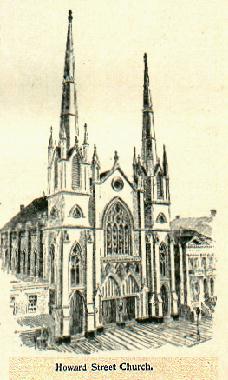 A
gleaming scrap of history in this connection is worth a special record.† Just prior to this organization, a home near
the corner of Essex and Folsom streets, where the Folsom street church was
afterwards built, was a church in embryo, a leading factor in shaping future
history.† It was the home of Seneca
Jones.† With his devoted wife and family
he left Cincinnati, Ohio, on Christmas Day, 1849, for California, traveling by
stage over the Allegheny Mountains to New York.†
At Brooklyn he purchased a house all ready packed and prepared four-year
erection.† On the clipper ship Saratoga, Captain Trask commanding, he sailed from New York,
February 20, 1850, by the Cape Horn route, for his new home in the far
West.† After a stormy passage of six
months he reached San Francisco.† In due
time his house was built and was at that time one of the finest residents in
the city.
A
gleaming scrap of history in this connection is worth a special record.† Just prior to this organization, a home near
the corner of Essex and Folsom streets, where the Folsom street church was
afterwards built, was a church in embryo, a leading factor in shaping future
history.† It was the home of Seneca
Jones.† With his devoted wife and family
he left Cincinnati, Ohio, on Christmas Day, 1849, for California, traveling by
stage over the Allegheny Mountains to New York.†
At Brooklyn he purchased a house all ready packed and prepared four-year
erection.† On the clipper ship Saratoga, Captain Trask commanding, he sailed from New York,
February 20, 1850, by the Cape Horn route, for his new home in the far
West.† After a stormy passage of six
months he reached San Francisco.† In due
time his house was built and was at that time one of the finest residents in
the city.
He consecrated that new
home about April 14, 1851, by the organization of a Sunday school.† The scholars were his own children and those
of the neighborhood.† He was superintendent,
and his wife was chorister and teacher.†
There are fadeless garlands for such enthusiasm, and starset crowns for
such builders of Christian life in character.†
He lifted not be embroidered banner of a selfish life, but in his house
and in his business in the world, worked for the betterment of his neighbors,
with potency of the soul enshrining consecrated energies ever ready for
duty.† Two of his sons afterward became
honored members of the California Conference.
This home-school --
vigorous and prophetic-- became a part of the organization at Happy Valley
schoolhouse.† The increasing
congregations and the expanding experience of the new society demanded quarters
larger than the schoolhouse and better adapted to church work.† Events were moving rapidly.† The Oregon and California Conferences were
created by the action of the General Conference, which convened in Boston, in
May, 1852.† At that Conference, Rev. E.
E. Ames, D. D., was elected and ordained as Bishop, and his first Episcopal
tour was made to these new Conferences.†
Up to this time no event had focalized such interest, centralized such
expectations, or awakened greater hopes than the arrival of Bishop Ames in San
Francisco, in January, 1853.† The
Methodists of the coast gave him a royal welcome.† The service in the Happy Valley schoolhouse,
on Sabbath, January 24th, when he preached his first sermon in the State, was
of intense interest and was the more impressive because of the baptism by the
Bishop, of the infant daughter of J. W. and Mrs. Whiting, the first child that
had been baptized in the society.† Two
other events signalized the day.† A
quarterly Conference was held, at which the first Board of Trustees was
chosen.† Those to whom this special trust
was committed were: J. W. Whiting, Seneca Jones, W. H. Coddington, James
Christy, Charles Merriman, Horace Hoag, John Payne.† This pronounced the final organization of the
second Methodist church of San Francisco.†
The other action of this quarterly Conference was granting a license to
the first local preacher--John Bennum--and recommending him to the annual Conference.† He was received as a traveling preacher, and
appointed to a circuit in the mines.† He
was remembered as a man of attractive Christian character with a complete
concentration to the work of the ministry.†
Soon after his appointment his work suddenly closed, as he was drowned
in an attempt to ford a swollen stream.†
He passed from labor to eternal reward.
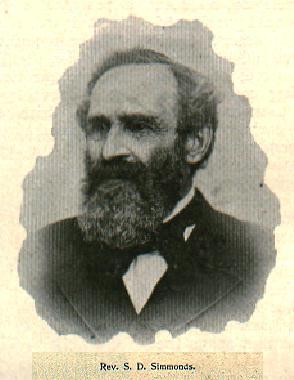
The first session of the
California Conference was held in the Powell street church, February 3, 1853,
Bishop Ames presiding.† Keen
discrimination and rare judgment were required to brightly adjust the work of
these feeble churches, planted in the midst of such difficult and perplexing
surroundings, and to project the lines further aggressive movements of
Methodism in California.† Results prove
that the Bishop commended the situation in his thought, and with a masterful
analysis solved some of the tangle problems of that hour which were to
determine the future.† At the close of
this memorable conference, the trustees in membership of the churches thus far
organized in San Francisco heroically faced the future of difficult duty,
discouragements and earnest service, with forceful swing of brilliant conquest.† This was especially true of the Second
church, under the leadership of Rev. N. P. Heath as pastor.† The selection of a lot on Folsom street
proved unwise, because situated amid sand dunes and sand drifts, and too far
from the center of population.† The
troubles of this heroic society did not cease with the erection of a house of
worship, which was dedicated January 7, 1854.†
A five-thousand-dollar mortgage and one hundred and fifty dollars per
month as interest gave no good cheer to that noble band of Christians.† The burden was too heavy, and the
discouragements accumulated and would have resulted in dismemberment but for
the timely assistance of the Missionary Society of the church at-large.† The years that followed were eventful ones,
ensphering a record of self-denial, patient service and persistent duty, that
can never be fully written.† The whole
history of early Methodism in San Francisco and California is a battle-music
pouring forth its rhythm of final victory.†
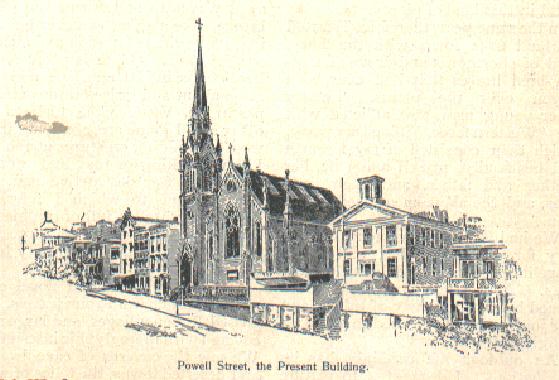

Source: The Californian
Illustrated Magazine, December 1892-May 1893, Volume III, Edited by Charles
Frederick Holder.† San Francisco.
© 2002 Nancy Pratt Melton
*I went to your
Golden Nugget Library, and in reading about the first Methodist Church of San
Francisco, found two of my ancestors, Rev Asa White and John Trubody and a
third that is called Lament, a son-in-law of Asa White. That name is
incorrect; his name is Hiram E Ament, married to Sarah White daughter of Asa
White. (Asa White was my 3rd-g-grandfather. and Hiram Ament was my 2nd-g-grandfather.)
Rev Asa White left SF to go to Uniontown, Humboldt Co, (Arcata) to start a
church there. He was affiliated with churches all over No Calif, until his
death in St Helena, Napa Co, on the 8th of Nov 1873. John
Trubodyís son, Josiah, married a daughter of Hiram Ament, her name was
Sophronia. Asa Preston White, son of Rev Asa White, married Hiram Amentís
daughter Mary Jane. Asa Preston White also became a minister in No Calif,
he died in 1916. Both Asas and their wives are buried in the St Helena
City Cemetery, as well as other members of the White family.
The White family also helped to build the
Church. From records from the Pacific School of Religion in Berkeley it
states, that Asa and his sons hauled redwood logs from the hills behind, what
is now Oakland, to San Antonio, a small area near the SF Bay by Alameda, and
floated them to a mill in or near SF.
The First Methodist Church in Arcata held a 150th
anniversary of the Church, that Rev Asa White founded, in June of 2000, which
my Uncle and I attended, along with a couple of other descendents of Rev Asa
White. We were treated royally, by the minister and congregation. We had
a great time.
This is a short version of the White, Ament and
Trubody families.
Below was taken from California Narratives, A
Ministers Life, by Rev William Taylor;
Brother Trubody introduced me, Reverend William
Taylor, to Brother Asa White's family. Brother White was a local preacher from
Illinois, but more recently from Oregon. His sons and daughters, of whom he had
a large family, were sociable and kind, and were all members of the Church.
They lived in the woods, on Washington St, near Powell in the neighborhood
where our chapel was being built. Their habitation was a small rough board
house, one story high, covered with a blue cotton cloth. It was known in familiar
Methodist parlance as " the shanty with the blue cover ," and was the
rallying point of Methodism in the city, where the prayer and class-meetings
were held every Sabbath, conducted by Brother White, who had authority from Rev
William Roberts, the superintendent of the "Oregon and California Mission
Conference," to do the best he could in collecting and holding the little
society together till the missionary should arrive.
Rev. William Roberts organized a small class in San
Francisco, in the summer of 1847. When he arrived he found the Sunday
School library in the care of Brother White, who reorganized it in the
spring of 1849. The first "night watch meeting" ever held in
California came off in our Powell St. Church.
The first quarterly meeting in California was held in our
chapel on Powell St. It commenced by the organization of a quarterly
conference, on Saturday night, December 2nd 1849. John Trubody, Alexander
Hatler, and Willet McCord were elected stewards. Resolutions were passed, expressing
thanks to the Missionary Board for sending them a Missionary, and pledging
themselves for his support, beyond the appropriation they had already made.
Asa White, now past the meridian of life, a hardy
suntanned pioneer of the woods, was a man of good common sense, and a very
generous heart, a local preacher of moderate abilities, a good exhorter, full
of fire. He had three married daughters with him at that time, who, with his
good wife and two of his sons-in-law, were all zealous Methodists. They could have
a good meeting anytime, whether anybody else came or not. They were closely
bound together as a family band, by mutual confidence and ardent affection, and
could have made a fortune, and done a great deal of good in almost any place in
California, had they settled down; but they had been pioneers all their lives,
moving westward in the van of early migration, and having reached the western
limits of the continent, they spent their time moving up and down the shore,
now in Oregon, now in California, then again to Oregon, then back to
California, men, women, children, all the same mind, and all moving together.
They seemed, by their constant migrations, to say " O that we had a new
continent of unbroken forests, unscathed by the axe of civilization, well stocked
with Indians, panthers, wildcats, bear, deer, elk, raccoons, and opossums, that
we might spend our days crossing it, and entertain ourselves in shooting game,
felling timber, building log cabins, and in surprising pioneer Methodist
preachers with our backwoods refinement and extraordinary sympathy and
kindness.†
Please Note: the marriage info on Asa Preston White, who married Mary Jane Ament.† Well, he didn't marry his niece although Hiram
Ament's wife is Asa Preston White's older sister.† Mary Jane was from Hiram Ament's first marriage to Nancy Harris, who died in child birth or soon after, in 1837.† (29 April 2008) †Cliff†† cday@surewest.net
Here is a little more on John T Trubody of the ME Church;
Memorial and Biographical History of Northern California Lewis
Publishing Co., 1891, pg 373
John & Jane Palmer Trubody, both natives of Cornwall,
England, came to this country in 1833, and settled in Pennsylvania, after,
removing to Lexington, Missouri, where they lived for ten years. In 1847 the
family, consisting of the parents and two children, William and Josiah P,
crossed the plains with ox teams, with a party which was formed on the road in
the spring of that year. The reached California early in October,
locating at Sutterís Fort, and remaining there about two months, when they
moved to San Francisco, then Yerba Buena, where the father worked for a time at
his trade, which was that of a carpenter. Soon after the discovery of
gold at Sutterís mill, he, as did every other white man in California, went to
the mines. After about six months of work in the mines, in which he was
quite successful, he returned to San Francisco and invested his earnings in
real estate. He built the first brick house ever erected in the city, and
also the first marble front, on Dunbar Alley and Washington St, with marble he
imported from New York. Coming to this coast before gold was thought of
in connection with the country, he figured conspicuously in the history of the
State; but in the main his life has been devoted to the promotion of the
religious and material interests of the city where he so early made his
home.††† Cliff†† cday@surewest.net